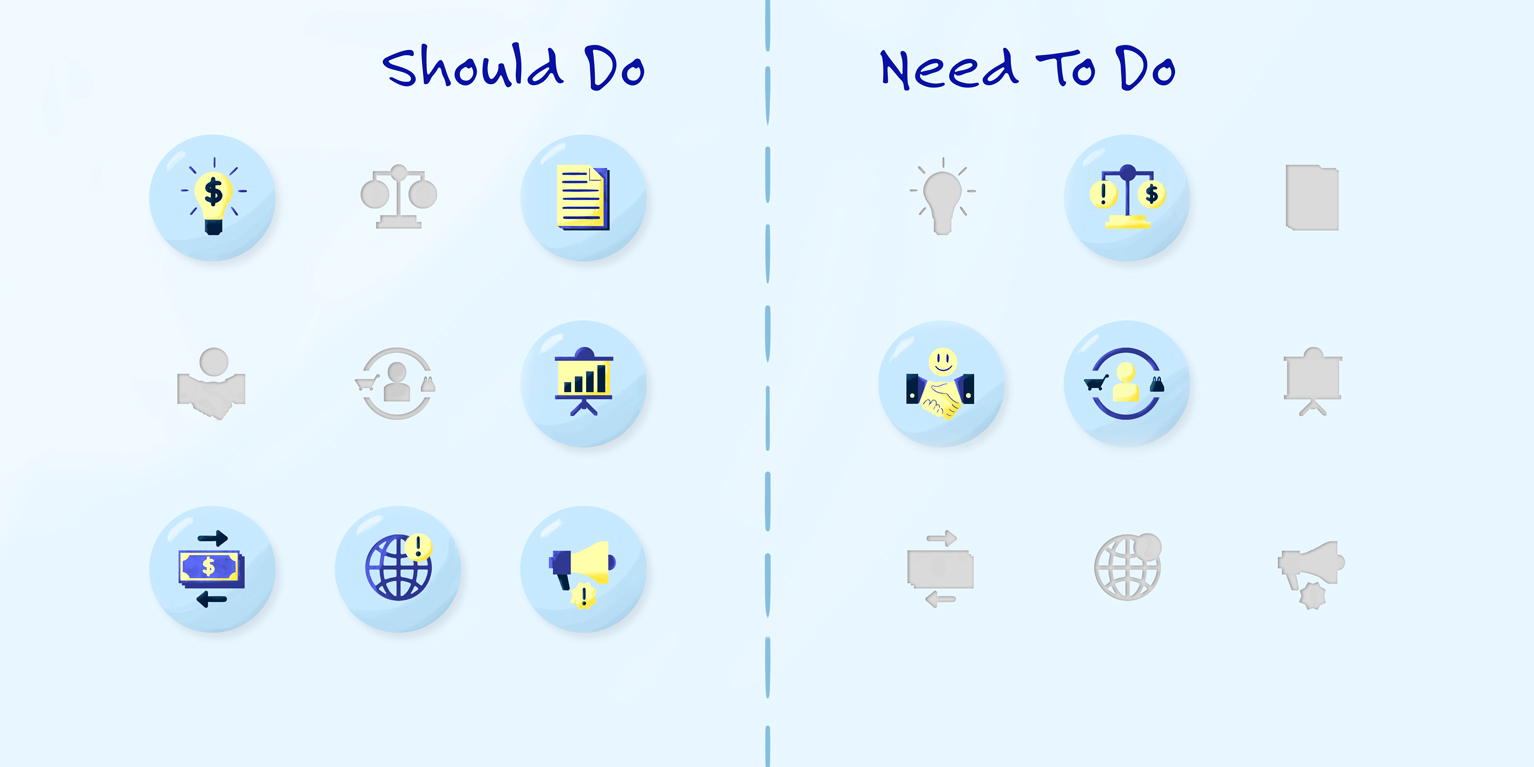Should Do or Need to Do? How to Spot the Difference in Your Business Strategy
When trying to make decisions for your business it’s easy to get caught up on what you should do to succeed, versus what you need to do to succeed. If you’re having trouble spotting the difference, let’s be clear: the ‘should do’s’ are the things that everyone else recommends. They can run the gamut from investing in the latest, cutting-edge technology, to disrupting the way you engage customers, expanding into new products or services, or reimagining your brand.
The ‘need to do’s’ are generally much simpler, more streamlined, but far more critical. They are the things that keep your business moving forward. They directly impact your bottom line.
The should do’s are not unimportant, and many times they can quickly evolve into the need-to-do list. Your need to do’s are also not static in nature. They evolve over time, and often you’ll find what was critical in 2021, for example, may not matter much at all a year from now.
One of the biggest questions we are asked by our clients is ‘what is truly important?’ We recently shared details on how to effectively manage project portfolios to ensure that you’re properly prioritizing the need to do’s without losing sight of the should do’s. Having worked with hundreds of companies across a wide variety of industries and ranging from small startups to global corporations, we’ve learned a bit about the need-to-do’s. Read on to discover the areas that make the most difference to a company’s bottom line and, ultimately, to its long-term success.
Highly personalized customer relationships
It may be trite, but it’s also true: your business does not exist without your customer. This makes customer relationships the most important need-to-do on your list. If your customers are less than satisfied, your business suffers.
The tricky thing about customer relations is that it can be ever-changing. What customers want and need can often be swayed by outside circumstances, trending preferences or growing diversity in your core base. For example, customers in 2021 may be highly mindful of a larger, cultural persona for your business and they may expect your company to take a stand on social issues. Customers today also often expect highly personalized or customizable services, delivery on demand and a pay-for-only-what-you-use mentality. All of these expectations have an impact on your engagement efforts.
Customer retention and satisfaction are so critical, they must be woven into every initiative and project your company undertakes. This requires utilizing data to better understand your customer, creating an omnichannel approach to meet them where they are and empowering every person in your organization with the responsibility of creating a positive customer experience. Believe it or not, investing in strategic planning helps align your company to a customer-first mentality.
Cultivate employee-partners
In a previous article, we talked about the critical need for creating a robust employee engagement program, especially in a post-COVID world, where many employees feel isolated, are working remotely or are navigating significant personal challenges. Beyond COVID, however, strong employee relations make good business sense.
It is often suggested to treat employees like family, and while the sentiment behind that comes from the right place, the reality is far less fruitful. Family, after all, can still take advantage of you. A ‘family mentality’ can overlook failure in order to spare feelings. It may be better to empower your employees with a partner-based mindset, helping them to see that the company’s success is their success too.
Allowing employees to build ownership in the business looks differently in different companies. Sometimes its stock ownership, or a distribution of profit. Other times it may be as simple as allowing them to manage upward, or encouraging them to share ideas with the C-suite. No matter how you approach it, treating employees like invested partners help to cultivate a more engaged, invested workforce.
Employees agree that the partner-concept works for them as well. Research suggests those who see their direct superior as a ‘partner’ rather than a ‘boss’ experience a level of satisfaction equal to a doubling of the household income.
Create an appetite for risk, but budget wisely
Once you have your business in a comfortable position, it can be terrifying to consider change. However, as any good leader knows, change is crucial for growth. Understanding how your company can best navigate risk is an important first step. Developing a comprehensive risk appetite framework is a good place to start, and StrategyBlocks visually-based strategy dashboard can make it easy to see where your company’s strengths and weaknesses lie.
Just as important as your risk appetite, however, is keeping a close line on your budget. These two things can often overlap, as companies take on exciting new risk opportunities but fail to see the immediate consequences of financial over-extension. Cost control measures take time to create and even more time to implement, but they are critical to long term business success. Much like you would treat your own personal budget, don’t allow your business to over extend based solely on the promise of opportunity.
There is a never-ending to do list for any business looking to thrive in their market. But it’s worth the effort to carefully separate the ‘should do’s’ from the ‘need to do’s’ and to understand the difference. The mission critical activities that keep the business humming along are the ones that take priority, helping to put the ‘should do’s’ in their proper perspective.




Leave A Comment